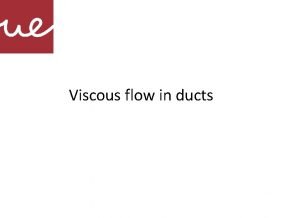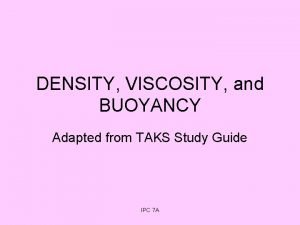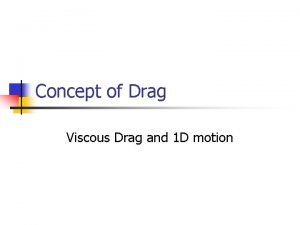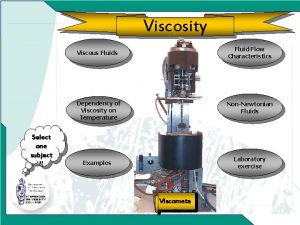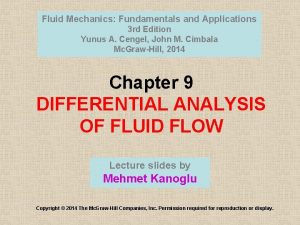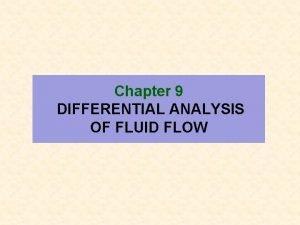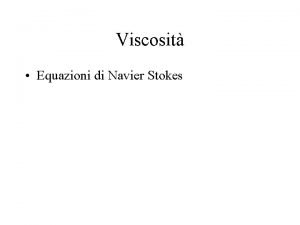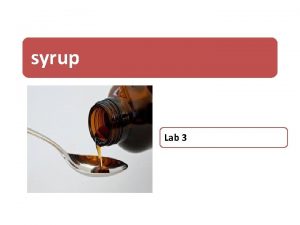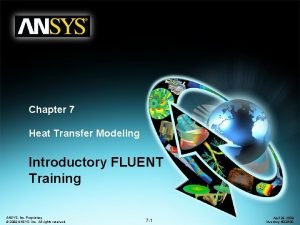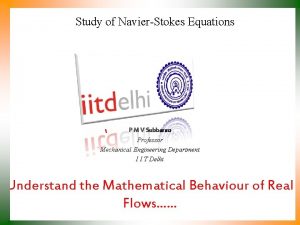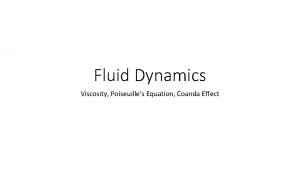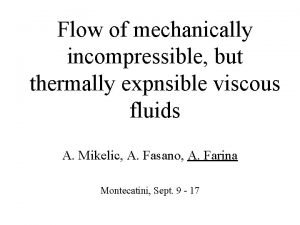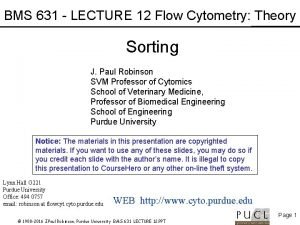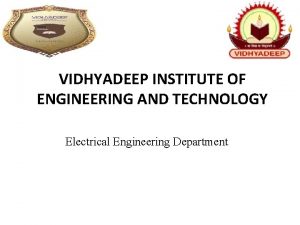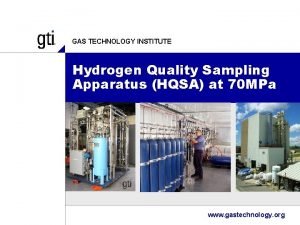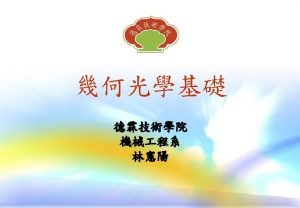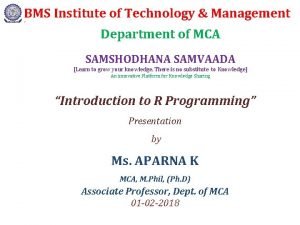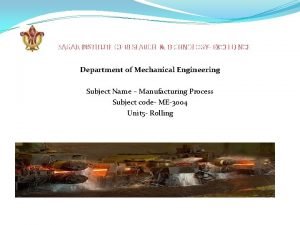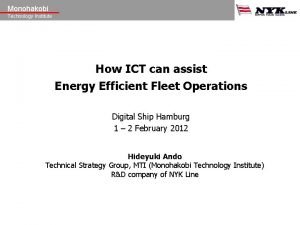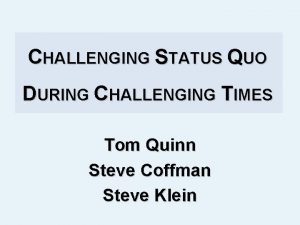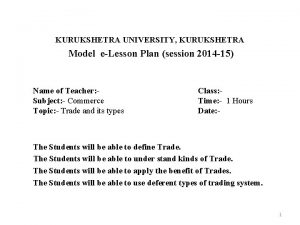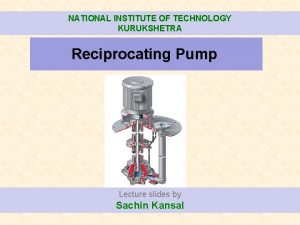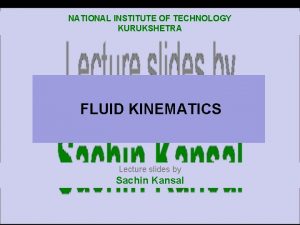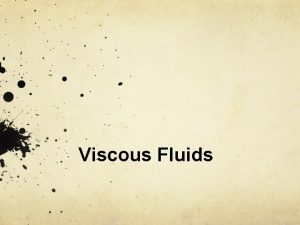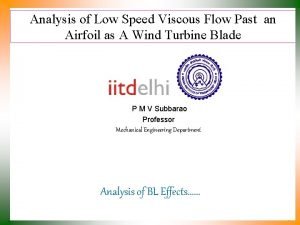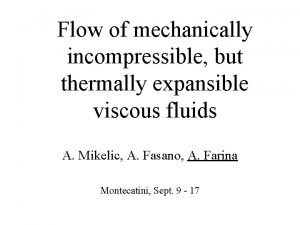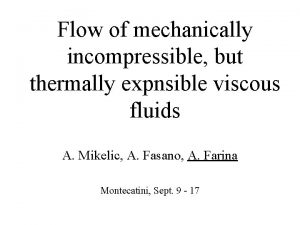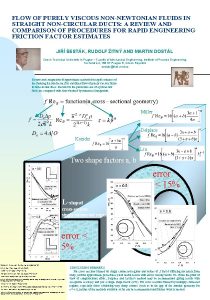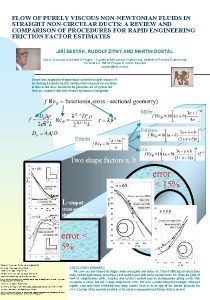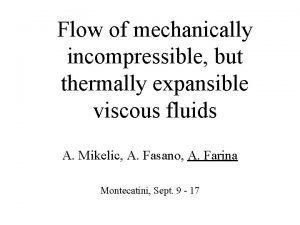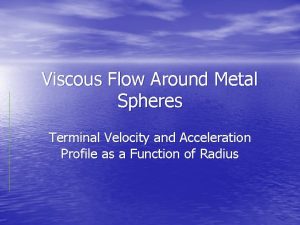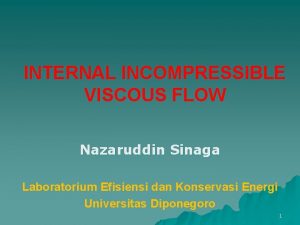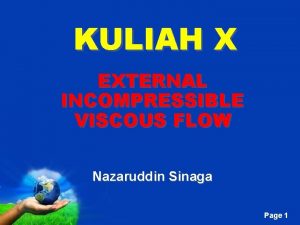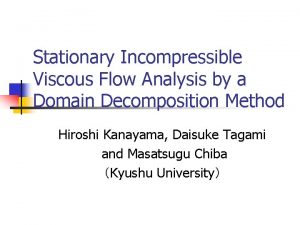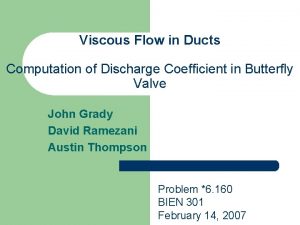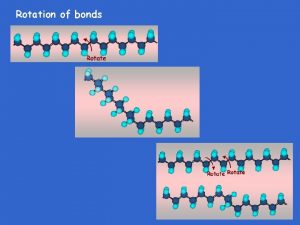NATIONAL INSTITUTE OF TECHNOLOGY KURUKSHETRA Viscous Flow Lecture








































- Slides: 40

NATIONAL INSTITUTE OF TECHNOLOGY KURUKSHETRA Viscous Flow Lecture slides by Sachin Kansal

Objectives • Understand the various factor affecting the fluid flow and Navier Stoke’s equation • To know various applications of Navier Stoke’s Equation • Understand the use of various applications of Navier Stoke’s Equation to calculate power absorbed in bearings • To know the various methods to estimate the viscosity of any fluid 2

Revision of topics already discussed in class 3

■ NAVIER STOKE’S EQUAION In class we have already derive Navier Stoke Equation i. e. 4

■ Relationship between Shear Stress and Pressure Gradient 5

Above Equation can also by derived by using Navier Stoke’ Equation. 6

Put the following conditions in Navier Stoke’ s Equation. 7

Application of Navier Stoke’s Equation 1) Laminar uni- directional Flow between Stationary Parallel Plates (Plane Poiseuille Flow) 2) Laminar uni-directional flow between parallel plates having relative motion 3) Laminar Flow in circular pipes (Hagen Poiseuille Flow) 4) Laminar Flow between concentric rotating cylinders 8

1) Laminar uni-directional flow between Stationary Parallel Plates b 9

This is the equation of Parabola. So velocity profile is parabolic in nature and velocity is zero for the fluid just in contact with plates 10

New topics not discussed in class 11

Maximum Velocity and Average Velocity 12

Shear Stress Distribution 13

Pressure Drop from one side to another 14

Practice Qus : 15

2) Laminar uni-directional flow between Parallel Plates having relative motion u=V at y=b b u=0 at y=0 16

This is the again looks like equation of Parabola. But the actual velocity profile depends upon the value of (dp/dx) Case I: If (dp/dx)=0 , then u= Vy/b, This is known as Simple Shear Flow or Plain Couette Flow 17

Case II: If (dp/dx)=-ve, then u= Vy/b + something Velocity distribution is as shown Case III: If (dp/dx)=+ve, then u= Vy/b -something Velocity distribution is as shown Case IV: If (dp/dx)=++ve, then u= Vy/b –something more Velocity distribution is as shown 18

3) Laminar flow in circular pipes 19

20

21

22

23

Shear Stress Distribution 24

Pressure Drop from one side to another 25

26

Movement of Piston in Dashpot üDaspot is a device used for damping the vibration of machine by using high viscous fluid üIt consist of a piston which moves in a cylinder. üDiameter of cylinder is slightly greater the piston. üPiston is connected to the machine element whose movement is to be restrained. üConsider a piston moving in a vertical dashpot containing oil as shown in fig 27

üThe oil flows through clearance behaves as laminar flow between parallel plates üPressure difference for the parallel plates is given by _ Where u = Av. Velocity 28

Equation shows that piston velocity is directly proportional to the load acting on the piston 29

Power absorbed in the Journal Bearing üA journal bearing is a hollow cylindrical enclosing a solid shaft that rotates about its axis at radial speed. üThe gap between bearing and shaft is filled by viscous oil and it will be consider at rest. Consider a Shaft Diameter of bearing (hollow cylinder) Length of shaft Clearance =d =D =L =t 30

Toque required to overcome viscous resistance 31

Power Absorbed = 32

Power absorbed in the Foot Step Bearing When a vertical shaft is required to rotate inside a fixed bearing, the viscous oil is placed between the top of the bearing and bottom of the shaft. R = Radius of shaft N = Speed of the shaft X= Clearance between bearing shaft 33

Toque required to overcome viscous resistance 34

Power required to overcome shear resistance 35

Methods of Measurement of Viscosity The device use for measurement of viscosity are known as Viscometer. Various Methods for Measurement of Viscosity. ü (i) Capillary tube Method ü (ii) Rotating cylinder Method ü (iii) Falling Sphere Method ü (iv) Orifice tube Viscometer 36

1) Capillary Tube Method üThis method use Hagen-Poiseuille equation for laminar flow through circular pipe. üA tank in which the liquid is filled whose viscosity is to be determined. 37

where Ɣ= w = Specific weight u= Average velocity In this way viscosity has to be determined 38

2) Rotating Cylinder Method üRotating Cylinder Method depends upon the Newton’s Law of viscosity üOuter cylinder of radius R 2 is made to rotate enclosing a viscous fluid and stationary cylinder of radius R 1 39

In this way viscosity has to be determined 40
 Hydraulic diameter formula
Hydraulic diameter formula Kuk digital results
Kuk digital results Unist ulsan national institute of science and technology
Unist ulsan national institute of science and technology Assistive technology implementation plan sample
Assistive technology implementation plan sample National institute of standards and technology
National institute of standards and technology National institute of agricultural technology
National institute of agricultural technology Viscous trail
Viscous trail More viscous
More viscous Viscous drag
Viscous drag Viscous fluid example
Viscous fluid example Fluid mechanics fundamentals and applications
Fluid mechanics fundamentals and applications Differential analysis of fluid flow
Differential analysis of fluid flow Equazione di navier stokes
Equazione di navier stokes Sweet/viscous
Sweet/viscous Fluent radiation model
Fluent radiation model Navier stokes equations einstein notation
Navier stokes equations einstein notation Coefficient of viscosity
Coefficient of viscosity Continity equation
Continity equation 01:640:244 lecture notes - lecture 15: plat, idah, farad
01:640:244 lecture notes - lecture 15: plat, idah, farad Flow cytometry lecture
Flow cytometry lecture Calc institute of technology
Calc institute of technology Vidhyadeep institute of engineering and technology
Vidhyadeep institute of engineering and technology Waterford institute of technology vacancies
Waterford institute of technology vacancies Masdar institute of science and technology
Masdar institute of science and technology Madhav institute of technology and science
Madhav institute of technology and science Grenoble institute of technology
Grenoble institute of technology Gastechnology
Gastechnology De lin institute of technology
De lin institute of technology Dbs institute of technology
Dbs institute of technology Materials technology institute
Materials technology institute Bms institute of technology & management
Bms institute of technology & management Vocational education uae
Vocational education uae Courseweb.sliit.lk
Courseweb.sliit.lk Sagar institute of research and technology
Sagar institute of research and technology Prajnanananda institute of technology & management
Prajnanananda institute of technology & management Monohakobi
Monohakobi Kigali institute of science and technology
Kigali institute of science and technology Netherlands maritime institute of technology (nmit)
Netherlands maritime institute of technology (nmit) Stevens institute of technology
Stevens institute of technology Reel to reel institute
Reel to reel institute Kth royal institute of technology notable alumni
Kth royal institute of technology notable alumni
